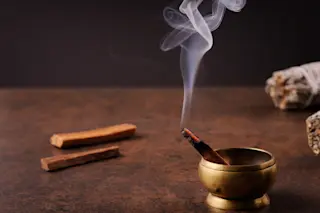Palo santo has quickly become a mainstay and trendy product sought after for its stated spiritual and medicinal properties, as well as its fragrant scent. Literally meaning “holy wood” in Spanish it’s related to the same family of plants as frankincense and myrrh and its uses dates back hundreds of years.
Where Palo Santo Comes From
Palo santo, also known by its scientific name of Bursera graveolens, comes from a shrub or tree that is native to tropical dry forests in many South and Central American countries such as Ecuador, Peru, Colombia, Guatemala, and Mexico. Graveolens translates to “strong-smelling," a nod to the incense-like scent emitted when a branch is broken.
Sustainability is a concern since the tree is not considered endangered and rising popularity has led to concerns of deforestation as dry forest areas where the plant originates are threatened.
Though Bursera graveolens is the least concern and considered stable, bad harvesting practices do take place. Most recently authorities in Peru detained nearly 12,000 kilos of palo santo wood that was cut down illegally; by law it must only come from trees that have died naturally.
As such, it is recommended to always check the source of palo santo wood prior to purchase to avoid harm to the natural world.
Read More: 7 Groundbreaking Ancient Civilizations That Influence Us Today
What Is Palo Santo Used For?
Palo santo is commonly used for a wide range of spiritual and medicinal purposes in its various forms. Traditionally, burning the wood or its resin and oil are used as a remedy for pain caused by ailments such as arthritis or to treat headaches, as well as to reduce inflammation, and stress. A scientific review paper found that palo santo does contain certain anti-inflammatory and pain-relieving properties.
It is also used to cleanse negative energy from households or rooms – in a practice known as smudging – and is frequently used in yoga studios or during meditation. Prior to modern usage, the Incas burned palo santo in rituals and religious practices to drive away evil spirits.
Palo santo is considered an effective insect repellent, as it is said to help ward off mosquitoes, flies, and ants as it contains limonene and other compounds that can act as natural repellents. Though many of these uses date back centuries, scientific evidence of their effectiveness remains somewhat limited, even with some researchers studying it.
Read More: How Slow, Deep Breathing Taps Into a Natural Rhythm in Our Bodies
How to Use Palo Santo
Palo santo is often burned as incense or its oil is used in a diffuser. In the practice of smudging, the palo santo is lit, blown out after around 30 seconds and then its smoke can be wafted around a room or space. Likewise, its oil or resin is applied to the skin as a natural remedy.
When used as an oil, health experts recommend first testing it on a small area of skin for a number of days to ensure no adverse reactions occur. When burning palo santo, it is advised to do so in a well ventilated room and avoid prolonged use in places such as bedrooms. Smoke inhalation is associated with a number of illnesses due to the release of numerous chemicals and gases and can acerbate existing conditions such as asthma.
Read More: 7 Health Home Remedies That Are Actually Effective
Is Palo Santo Safe for Pets?
The use of palo santo around pets is not advised, particularly any prolonged or direct exposure. Pets can have greater sensitivity than their owners, and it is important to observe any reactions or displays of avoidance if palo santo is used in their presence. Palo santo can irritate cats in particular and it can be toxic.
Rooms should always be well ventilated during and after use, and pets should not be left alone with palo santo products to avoid chewing or ingestion, or while it burns. It is advised to talk to a veterinary professional prior to using palo santo products in a household with pets.
Read More: What Are Chakras and How Many Are There?
Article Sources
Our writers at Discovermagazine.com use peer-reviewed studies and high-quality sources for our articles, and our editors review for scientific accuracy and editorial standards. Review the sources used below for this article:
IUCN Red List. Bursera graveolens
Kew. Plants of the World Online. Bursera graveolens
Darwin Foundation. Bursera graveolens (Kunth) Triana & Planch
New York Times. Is Palo Santo Endangered?
Agencia Agraria de Noticias. Peru exported 70.6 tons of palo santo in the first quarter of 2023
International journal of molecular sciences. Analgesic-Like Activity of Essential Oil Constituents: An Update
Ecuador.com. Palo Santo: Myths and Reality
Health.com. The 7 Best Mosquito Repellents to Keep the Bugs Away, Tested and Reviewed
The Journal of Supercritical Fluids. Evaluation of the biological activity and chemical profile of supercritical and subcritical extracts of Bursera graveolens from northern Peru
Health.com. Everything You Need To Know about the Benefits and Uses of Palo Santo
Palo Santo Supply. An In-Depth Look At Smudging With Palo Santo Wood
Healthnews. Palo Santo: Benefits For Your Health















